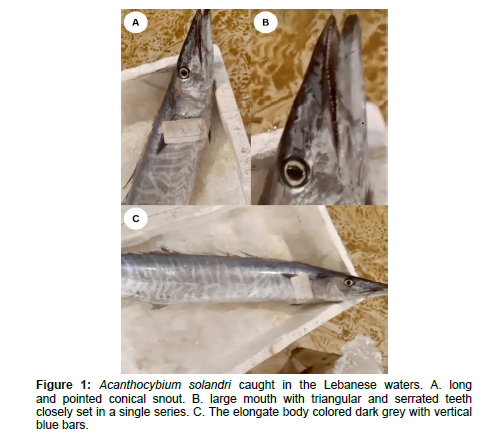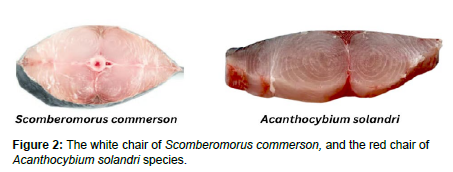Catch of the Day: The Wahoo Acanthocybium solandri (Cuvier, 1832) in the Lebanese Waters, Eastern Mediterranean
Received: 01-Jan-2024 / Manuscript No. jflp-24-126378 / Editor assigned: 03-Jan-2024 / PreQC No. jflp-24-126378 / Reviewed: 17-Jan-2024 / QC No. jflp-24-126378 / Revised: 22-Jan-2024 / Manuscript No. jflp-24-126378 / Published Date: 29-Jan-2024 DOI: 10.4172/2332-2608.1000490
Short Communication
Wahoo, Acanthocybium solandri (Cuvier, 1832), is a pelagic species of the Scombridae family, and the only species of the genus Acanthocybium Gill, 1862 [1]. A. solandri is widely distributed throughout the tropical and subtropical oceanic waters [2] of the Indian [3-5], Atlantic [6-15], and Pacific oceans [4-5] including the Red [16], Mediterranean [2-17-19], and Caribbean seas [20]. However, the distribution of the wahoo species in the Mediterranean Sea has not been precise until today. Accordingly, only a few individuals of A. solandri have been reported around Sicily [17-18]. To the best of our knowledge, the wahoo species have never been reported in the southern Levantine Sea. However, [21] has mentioned that “No quantitative data exists and only anecdotic information is available” in the Lebanese waters. In this context, these notes aim to report the first confirmed specimens of Wahoo Acanthocybium solandri caught from Lebanese waters south of the Levantine Sea.
On 22 January 2024, a video of a scombrid pelagic fish (e.g., caught as Scomberomorus commerson) was shared with one of us (SF) by a fish market owner from Al-Arida, north of Lebanon. After an investigation by the authors (especially RA), it has been clear that the species is the wahoo Acanthocybium solandri. Consequently, fishers in the area have been interviewed by SM, and it has been confirmed that the specimen was caught during a fishing trip (targeting Mackerel, Tunas) at 35 m depth bycatch in fishing nets in Al-Arida waters, north Lebanon. In Addition, fishers from the area confirmed he catch of one other wahoo individual in the same area on 01 January 2024, and a photo has been shared with SM. As a result, the wahoo specimen caught on 22 January 2024 was 90 cm in length and 4 kg in weight. Based on the morphology, the wahoo specimen was characterized by its elongate, fusiform, subcylindrical body, colored dark grey with vertical blue bars (Figure 1A, and 1C). In addition, it was distinguished by its long and pointed conical snout (much shorter than the rest of the head [2]), and a large mouth with triangular and serrated teeth closely set in a single series [2-16] (Figure 1A, and 1C).
It is worth noting that A. solandri has a Mediterranean distribution [2-17-19]. However, only some individuals have been confirmed to be present in this area [17-19]. In this context, this note aims to increase the presence of wahoo in the Mediterranean Sea.
The wahoo individuals in Lebanese waters may belong to the Indo-Pacific population (e.g., as a genetic differentiation between the wahoo population of the Atlantic and Indo-Pacific has been confirmed [22-23]). Accordingly, the recorded wahoo specimen may come from the Red Sea through the Suez Canal. A. solandri is a hard swimmer due to its gills specialization [24]. Wahoo is a high predator of flying fish, squids, and other prey [2-7-10-13-14-17-20, and references therein]—possible confusion with Scomberomorus commerson; however, the wahoo species is distinguished by its red chair (authors.pers.comm.fishers) (Figure 2). In addition, the Wahoo is a gonochoristic species with multiple spawning of buoyant eggs and is fast-growing [7-11-13-15]. Accordingly, it is highly requested for its commercial [10-12-14-17-25] and recreational (e.g., the Wahoo is appreciated as a gamefish) values [17]. However, A. solandir is a high parasite-carrying fish [5-17-26-27].
Based on the fact that the wahoo is an important species in fisheries in many countries [10-12-14-17-25]. Suppose it finally establishes in the Mediterranean Sea and gets an abundant population. In that case, it can become an important resource for Mediterranean fishers, as has already happened with the rabbitfish (Siganus spp.) and the blue crab (Callinectes sapidus) (pers.comm.RA). Fom a monitoring point of view, it is necessary to estimate/ or evaluate the existing population of A. solandri in the Mediterranean Sea. As well as it is essential to understand the wahoo Mediterranean population, ecology, biology, connectivity with the wahoo population of the Atlantic/ Indo-Pacific Ocean, and its impacts/ benefits on humans/and ecosystems.
References
- Froese R, Pauly D.Editors (2024) FishBase. Acanthocybium solandri (Cuvier, 1832). Accessed through: World Register of Marine Species.
- Collette BB, Nauen CE (1983) FAO species catalogue. Scombrids of the World: An annotated and illustrated catalogue of tunas, mackerels, bonitos and related species know to date. FAO Fisheries Synopsis 2: 137.
- Siddeek MSM (1995) Review of fisheries biology of Scomberomorus and Acanthocybium species in the Western Indian Ocean (FAO Area 51).
- Palomares MLD, Froese R, Derrick B, Nöel S-L, Tsui G, et al (2018) A preliminary global assessment of the status of exploited marine fish and invertebrate populations. A report prepared by the Sea Around Us for OCEANA 60.
- Zischke MT, Griffiths SP, Tibbetts IR, Lester RJ (2013) Stock identification of wahoo (Acanthocybium solandri) in the Pacific and Indian Oceans using morphometrics and parasites. ICES Journal of Marine Science 70: 164-172.
- Pascual-Alayón PJ, Casañas-Machin I, Báez JC, Ramos ML, Abascal FJ (2019)THE WAHOO Acanthocybium solandri (Cuvier, 1832) FISHERY IN El HIERRO ISLAND (CANARY ISLANDS, SPAIN) and Biology in the East Atlantic Ocean. Centro Oceanográfico de Canarias.
- Triay-Portella R, González JA, Lorenzo JM, Correia S , Pajuelo JG (2023) Reproductive biology of wahoo (Acanthocybium solandri) in the Canary Islands (eastern-central Atlantic). Regional Studies in Marine Science, 65, 103076.
- Viana DL, Hazin FHV, Nunes D, Carvalho F, Véras D, et al. (2008) Wahoo Acanthocybium solandri fishery in the vicinity of Saint Peter and Saint Paul Archipelago, Brazil, from 1998 to 2006. ICCAT 62: 1662-1670.
- Azevedo J, Heemstra PC (1995) New records of marine fishes from the Azores. ARQUIPÉLAGO. Ciências Biológicas e Marinhas Life and Marine Sciences 13: 1-10.
- Theisen TC, Baldwin JD (2012) Movements and depth/temperature distribution of the ectothermic Scombrid, Acanthocybium solandri (wahoo), in the western North Atlantic. Marine Biology 159: 2249-2258.
- Oxenford HA, Murray PA, Luckhurst BE (2003) The biology of wahoo (Acanthocybium solandri) in the western central Atlantic. Gulf and Caribbean Research 15: 33-49.
- Kindong R, Wu F, Sarr O, Dai L, Tian S, et al. (2022) Life history of wahoo, Acanthocybium solandri, in the Tropical Eastern Atlantic Ocean–the importance of applying a suite of methods for fisheries assessment in data-limited situations. Oceanological and Hydrobiological Studies 51: 115-132.
- Puerto MA , de Urbina JO, Gómez-Vives MJ, Pascual-Ayalón JP (2023) REPRODUCTIVE BIOLOGY OF WAHOO, ACANTHOCYBIUM SOLANDRI (CUVIER, 1832), OF EASTERN ATLANTIC. ICCAT 80: 102-111.
- Kindong R, Wu F, Sarr O, Dai L, Tian S, et al. (2022) Life history of wahoo, Acanthocybium solandri, in the Tropical Eastern Atlantic Ocean–the importance of applying a suite of methods for fisheries assessment in data-limited situations. Oceanological and Hydrobiological Studies 51: 115-132.
- Triay-Portella R, González JA, Lorenzo JM, Correia S, Pajuelo JG, et al. (2023) Reproductive biology of wahoo (Acanthocybium solandri) in the Canary Islands (eastern-central Atlantic). Regional Studies in Marine Science 65: 103076.
- Williams CT, Arostegui MC, Braun CD, Gaube P, Shriem M, et al. (2022) First records of two large pelagic fishes in the Red Sea: wahoo (Acanthocybium solandri) and striped marlin (Kajikia audax). Journal of the Marine Biological Association of the United Kingdom 102: 505-508.
- Romeo T, Azzurro E, Mostarda E ( 2005) Record of Acanthocybium solandri in the Central Mediterranean Sea, with notes on parassites. J.Mar.Biol.Ass.UK, 85: 1295–1296.
- Relini LO (2010) Nonnative marine fish in Italian waters. Fish invasion of the Mediterranean Sea: Changes and renewal. Pensoft Publishers, Sofia–Moscow 267-292.
- Di Natale A, Srour A, Hattour A, Keskin C, Idrissi M, et al. (2009)Regional study on small tunas in the Mediterranean including the Black Sea. Studies and Reviews. General Fisheries Commission for the Mediterranean 85: 132.
- Gough B, Prouse A, Dance MA, Wells RD, Rooker JR (2023) Regional Variation in the Trophic Ecology of Wahoo (Acanthocybium solandri) in the Western Atlantic Ocean. Fishes 8: 519.
- Bariche M, Di Natale A (2019) Preliminary information on the Atlantic bluefin tuna (Thunnus thynnus) fishery in Lebanon. Collective Volumes of Scientific Papers ICCAT 75: 1278-1281.
- Garber AF, Tringali MD, Franks JS (2005) Population genetic and phylogeographic structure of wahoo, Acanthocybium solandri, from the western central Atlantic and central Pacific Oceans. Marine Biology 147: 205-214.
- Haro‐Bilbao I, Riginos C, Baldwin JD, Zischke M, Tibbetts IR, et al. (2021) Global connections with some genomic differentiation occur between Indo‐Pacific and Atlantic Ocean wahoo, a large circumtropical pelagic fish. Journal of Biogeography 48: 2053-2067.
- Wegner NC, Sepulveda CA, Graham JB (2006) Gill specializations in high-performance pelagic teleosts, with reference to striped marlin (Tetrapturus audax) and wahoo (Acanthocybium solandri). Bulletin of Marine Science 79: 747-759.
- Theisen TC, Bowen BW, Lanier W, Baldwin JD (2008) High Connectivity on a Global Scale in the Pelagic Wahoo, Acanthocybium solandri (Tuna Family Scombridae). Mol Ecol 17: 4233-4247.
- Toksen E, Boxshall GA, Altinozek S (2012) Sagum posteli Delamare-Deboutteville & Nunes-Ruivo, 1954 (Copepoda: Siphonostomatoida: Lernanthropidae) parasitic on Epinephelus aeneus (Geoffroy Saint-Hilaire) in Turkish waters, with a key to the species of Sagum Wilson, 1913. Systematic parasitology 82: 71-80.
- Raja K, Maran V, Gopalakrishnan A, Saravanakumar A, Vijayakumar R, et al. (2014) Infestation of Lernaeenicus seeri (Copepoda: Pennellidae) and Hirudinella ventricosa (Digenea: Hirudinellidae) on wahoo Acanthocybium solandri collected from Parangipettai, southeast coast of India. Tropical Biomedicine 31: 477-486.
Citation: Fatfat S, Badreddine A, Aguilar R (2024) Catch of the Day:The Wahoo Acanthocybium solandri (Cuvier, 1832) in the Lebanese Waters,Eastern Mediterranean. J Fisheries Livest Prod 12: 490. DOI: 10.4172/2332-2608.1000490
Copyright: © 2024 Fatfat S, et al. This is an open-access article distributed underthe terms of the Creative Commons Attribution License, which permits unrestricteduse, distribution, and reproduction in any medium, provided the original author andsource are credited.
Select your language of interest to view the total content in your interested language
Share This Article
Recommended Journals
Open Access Journals
Article Tools
Article Usage
- Total views: 2136
- [From(publication date): 0-2024 - Sep 23, 2025]
- Breakdown by view type
- HTML page views: 1827
- PDF downloads: 309


